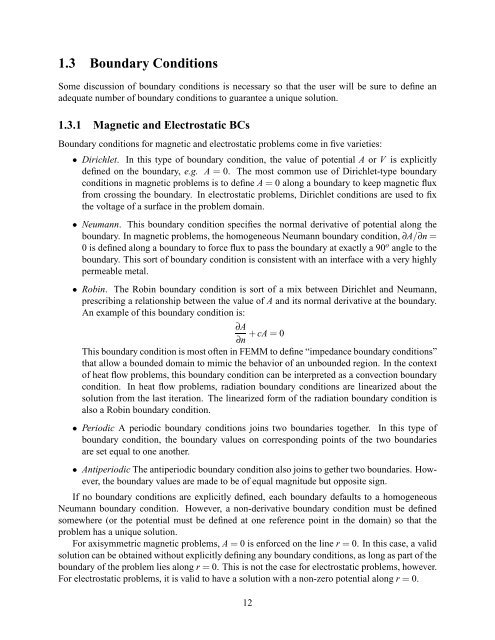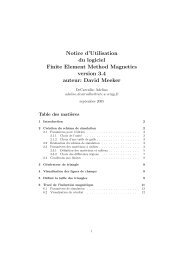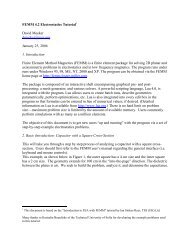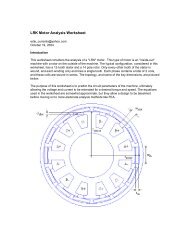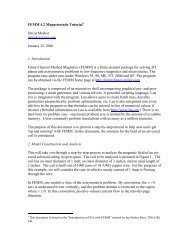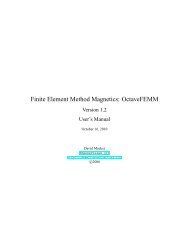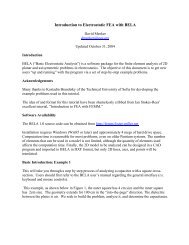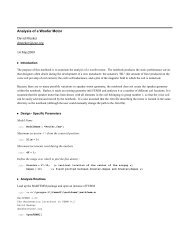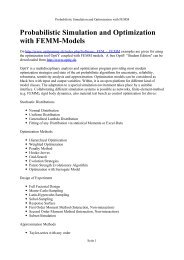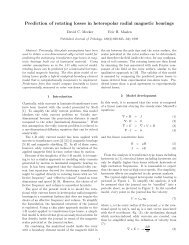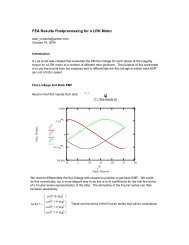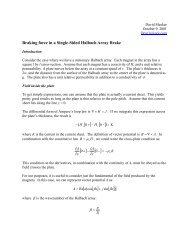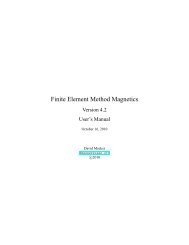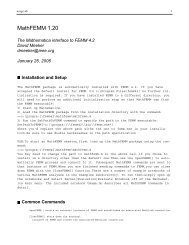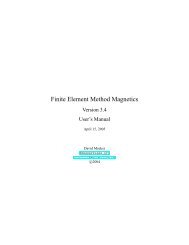FEMM Manual - Finite Element Method Magnetics
FEMM Manual - Finite Element Method Magnetics
FEMM Manual - Finite Element Method Magnetics
Create successful ePaper yourself
Turn your PDF publications into a flip-book with our unique Google optimized e-Paper software.
1.3 Boundary Conditions<br />
Some discussion of boundary conditions is necessary so that the user will be sure to define an<br />
adequate number of boundary conditions to guarantee a unique solution.<br />
1.3.1 Magnetic and Electrostatic BCs<br />
Boundary conditions for magnetic and electrostatic problems come in five varieties:<br />
• Dirichlet. In this type of boundary condition, the value of potential A or V is explicitly<br />
defined on the boundary, e.g. A = 0. The most common use of Dirichlet-type boundary<br />
conditions in magnetic problems is to define A = 0 along a boundary to keep magnetic flux<br />
from crossing the boundary. In electrostatic problems, Dirichlet conditions are used to fix<br />
the voltage of a surface in the problem domain.<br />
• Neumann. This boundary condition specifies the normal derivative of potential along the<br />
boundary. In magnetic problems, the homogeneous Neumann boundary condition, ∂A/∂n =<br />
0 is defined along a boundary to force flux to pass the boundary at exactly a 90 o angle to the<br />
boundary. This sort of boundary condition is consistent with an interface with a very highly<br />
permeable metal.<br />
• Robin. The Robin boundary condition is sort of a mix between Dirichlet and Neumann,<br />
prescribing a relationship between the value of A and its normal derivative at the boundary.<br />
An example of this boundary condition is:<br />
∂A<br />
+ cA = 0<br />
∂n<br />
This boundary condition is most often in <strong>FEMM</strong> to define “impedance boundary conditions”<br />
that allow a bounded domain to mimic the behavior of an unbounded region. In the context<br />
of heat flow problems, this boundary condition can be interpreted as a convection boundary<br />
condition. In heat flow problems, radiation boundary conditions are linearized about the<br />
solution from the last iteration. The linearized form of the radiation boundary condition is<br />
also a Robin boundary condition.<br />
• Periodic A periodic boundary conditions joins two boundaries together. In this type of<br />
boundary condition, the boundary values on corresponding points of the two boundaries<br />
are set equal to one another.<br />
• Antiperiodic The antiperiodic boundary condition also joins to gether two boundaries. However,<br />
the boundary values are made to be of equal magnitude but opposite sign.<br />
If no boundary conditions are explicitly defined, each boundary defaults to a homogeneous<br />
Neumann boundary condition. However, a non-derivative boundary condition must be defined<br />
somewhere (or the potential must be defined at one reference point in the domain) so that the<br />
problem has a unique solution.<br />
For axisymmetric magnetic problems, A = 0 is enforced on the line r = 0. In this case, a valid<br />
solution can be obtained without explicitly defining any boundary conditions, as long as part of the<br />
boundary of the problem lies along r = 0. This is not the case for electrostatic problems, however.<br />
For electrostatic problems, it is valid to have a solution with a non-zero potential along r = 0.<br />
12


